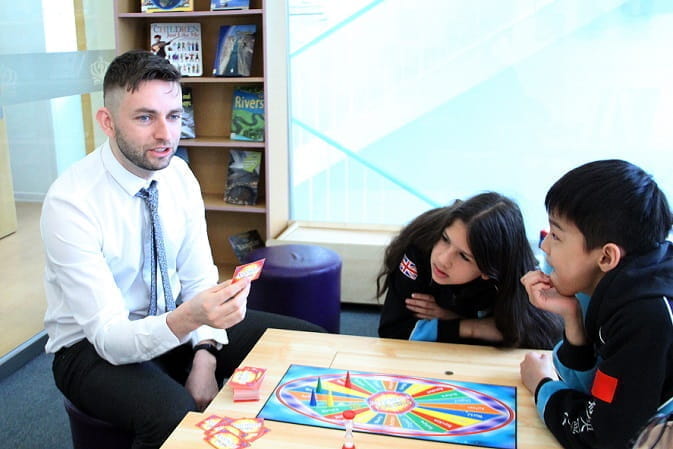We use cookies to improve your online experiences. To learn more and choose your cookies options, please refer to our cookie policy.

A common misconception is that children learn better with longer stretches of uninterrupted instructional time. This thought process directly equates the amount of time spent on a learning activity with the amount of learning taking place. However, it does not factor in the positive impact that breaks can have on learning. Timing of breaks can be just as important for learning as time that is spent on activities. Parents around the world are likely to have become more aware of the importance of breaks during Virtual School experiences over the past three years.
To understand how important brain breaks are, an adult context can be applied. When attending a day-long seminar or conference, adults will naturally check the schedule for the coffee break and lunch times. Dividing longer amounts of time into smaller more manageable segments is a method that is used by attendees and organisers to improve attentiveness and participation. These same principles can be applied to children.
The science behind breaks is that they give the brain time to rest, which leads to greater productivity and creativity. Brain imaging has shown that children learn better after a break. In fact, if children are not given enough scheduled breaks, their mind is still likely to rest naturally through daydreaming. This allows children to refresh and release all those neural circuits that get all bound up when they’re focused. Children shouldn’t be overly scheduled. Instead they need blocks of break time to promote spontaneity and creativity.
When schools started to reopen in 2020, many did so with new safety measures, such as mask-wearing for all children. To counteract this, additional outdoor breaks were timetabled in most schools in order to allow children some ‘mask- free’ time during the school day. Here at BSB Sanlitun, we added a fifteen-minute break in the afternoon for KS2 students. The positive and powerful impact this additional break had on learning was felt immediately by teachers. After their new fifteen-minute afternoon break, children were re-entering the classroom with a bounce in their steps. And most importantly, they were more focused during lessons.
Frequent breaks that aim to improve learning is not a new phenomenon. The Finnish school system, which consistently scores at or near the top in international education rankings, has been offering numerous breaks to their students since the 1960s. Students in Finland normally take a fifteen-minute break for every forty-five minutes of instruction.
The work of Anthony Pellegrini, author of the book Recess: Its Role in Education and Development supports anecdotal observations with data and empirical evidence. Pellegrini and his colleagues ran a series of experiments in U.S. public elementary schools to explore the relationship between recess timing and attentiveness in the classroom. In every one of the experiments, students were more attentive after a break than before a break. They also found that the children were less focused when the timing of the break was delayed—or in other words, when the lesson dragged on.
Another interesting finding from Pellegrini was that breaks don’t have to be held outdoors to be beneficial. In one of his experiments at a public elementary school, the children had their recess times inside the school, and the results matched those of other experiments where they took their breaks outside: after their breaks, the students were more focused in class.
It is therefore clear that frequent breaks keep students fresh throughout the school day. This logic can be transferred to homework or Virtual School. Parents can move to using breaks as a strategy to maximise learning. We no longer need to fear that students won’t learn what they need to learn if we let them disconnect from their work several times throughout the school day, be it at school, during Virtual School or even when completing a homework task.
There are different ways of offering little brain breaks which I describe below, but one of the most important things to remember is that they need to happen regularly in order to truly benefit children. As well as scheduled breaks, adults should also be observant during learning activities. If children seem to be dragging their feet before the forty-five-minute mark, it would seem beneficial to offer a brain break right away.
There are different types of brain breaks that can all offer a positive impact on learning. All of these are simple ideas that are easily adapted at home.
1.Physical brain breaks.
These brain breaks will get your child active and allow them to burn off some energy. This release of pent-up energy will have a positive impact on their focus.
Sample activities for physical brain breaks include work out videos, action songs and skipping.
2.Relaxing brain breaks
These brain breaks are allowing children to recharge their energy levels and also help them to decompress. They’re especially helpful if your child is starting to feel stressed about what they’re working on. Sample activities for relaxing brain breaks include calming music, yoga poses and meditation.
3.Sensory brain breaks
Fresh air can work wonders. Going outside gives children a change of scenery. It also helps revitalise the senses. Sample activities for sensory brain breaks include scavenger hunts, outdoor sensory bins and outdoor play.
4.Skill-building brain breaks
Children can still learn and develop new skills with these breaks. Their brains get to switch their focus to a new activity. Sample activities for skill-building brain breaks include jigsaw puzzles, learning to juggle and playing strategic board games.
Steve O'Leary is Year Group Leader of Year 5 at the British School of Beijing, Sanlitun. This is his 4th year at the school. Prior to this, he worked for 8 years both as a KS1 and KS2 class teacher, as well as KS2 Learning Support teacher in Dublin.